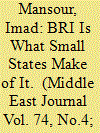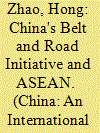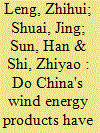|
|
|
Sort Order |
|
|
|
Items / Page
|
|
|
|
|
|
|
| Srl | Item |
| 1 |
ID:
176571


|
|
|
|
|
| Summary/Abstract |
Kuwait's expanding engagement with China's Belt and Road Initiative (BRI) sheds light on its strategies to meet its socioeconomic needs and navigate the Gulf's adversarial politics. The BRI presents a good case study of how the Kuwaiti leadership evaluates the benefits of and dilemmas created by asymmetric structural relationships. This article thus explores how governmental agency in strategically managing massive financial assets complicates our understanding of the vulnerability of so-called small states.
|
|
|
|
|
|
|
|
|
|
|
|
|
|
|
|
| 2 |
ID:
167925


|
|
|
|
|
| Summary/Abstract |
The ASEAN Economic Community (AEC) was launched at the end of 2015. It is an ongoing project towards a single market and is envisioned to develop ASEAN into a competitive and global ASEAN. However, given the wide development gaps between member countries, combined with ASEAN's extremely weak institutional base, it is uncertain whether ASEAN will be able to realise its ambitious targets. As the largest trading partner of ASEAN, China vowed to further deepen China–ASEAN relations and render more support to the building of the ASEAN community through China's Belt and Road Initiative (BRI). For ASEAN, the important question is how China and its initiatives could assist ASEAN member states in achieving those development priorities. This article attempts to address these questions by analysing Chinese scholarly writings and different Southeast Asian views and concerns. It also explores China's evolving peripheral diplomacy with a focus on its foreign policy to Southeast Asia.
|
|
|
|
|
|
|
|
|
|
|
|
|
|
|
|
| 3 |
ID:
171370


|
|
|
|
|
| Summary/Abstract |
China has become the leader in the wind energy industry and the “Belt and Road Initiative” provides a broad stage for China's international cooperation in this field. This paper examines the trade status of China's wind energy products in the “Belt and Road” countries, and measures the export potential and its determinants in the market of these countries, by adopting the gravity model with a balanced dataset of 19 products and 65 countries covering the period 2007–2017. The results indicate that: (1) China's wind energy product trade with the “Belt and Road” countries has grown rapidly, but the market structure is relatively concentrated; (2) The GDP and total energy consumption of the importing countries and China's wind power generation capacity have a positive impact on China's exports of wind energy products, while the physical distances between capitals of China and the importing countries have a negative effect; (3) The traditional market for China's wind energy product exports is becoming increasingly saturated, and 35 countries with untapped potentials and the growing markets are mainly distributed in the CIS, East Asia, West Asia, Central Asia and South Asia. Finally, this paper proposes corresponding policy implications based on these findings.
|
|
|
|
|
|
|
|
|
|
|
|
|
|
|
|
| 4 |
ID:
163895


|
|
|
|
|
| Summary/Abstract |
In 2013, China launched the Belt and Road Initiative (BRI), with the goals of securing China's energy sources and expanding its economic networks to the Asia‐Pacific region, North and East Africa, and the Mediterranean regions by way of Russia, Central and South Asia. Many of the BRI projects involve infrastructure building in China as well as in politically unstable or economically disadvantaged countries. To ensure a successful initiative and safeguard China's investments, issues of domestic and regional security become vital.
|
|
|
|
|
|
|
|
|
|
|
|
|
|
|
|
| 5 |
ID:
182622


|
|
|
|
|
| Summary/Abstract |
Laos is among the Southeast Asian countries that had engaged China on infrastructure cooperation well before the Belt and Road Initiative (BRI) was launched in 2013. Subsequently, Laos has embraced the BRI openly and receptively. Laos's most expensive and controversial project, the Vientiane-Boten railway, is China's signature BRI venture in Laos. The country's BRI engagement also includes special economic zones and unequal partnerships in hydropower, mining, and agricultural projects. To elucidate why Laos embraces the BRI despite the controversies and concerns surrounding the Beijing-backed projects, this essay uses an asymmetry-authority framework to argue that, while power asymmetry entails apprehensions, the Lao ruling elites' political needs to preserve and advance their authority led them to downplay anxieties and instead highlight the benefits of the China-financed projects. The rail venture, in particular, aims to transform Laos from a landlocked country to a "land-linked" one, which will extend connectivity, increase trade, and attract investment, thus enhancing and legitimizing the elites' rule.
|
|
|
|
|
|
|
|
|
|
|
|
|
|
|
|
| 6 |
ID:
170379


|
|
|
| 7 |
ID:
172280


|
|
|
|
|
| Summary/Abstract |
The growing role of local governments and municipalities in international relations has become a significant trend that has shaped new dynamics in global affairs. By analysing Guangdong's subnational diplomacy and Guangzhou city's diplomacy activities, this article aims to investigate whether, and to what extent, Chinese provinces, autonomous regions and municipalities possess the freedom to act independently in planning, organising and managing their internationalisation processes. The article also debates the growing role of centralisation inside China and its impact on shaping local governments international activities. Using the case study of Guangdong and Guangzhou, the author examines the following questions: How do both provincial and local governments conduct their activities under China's foreign policy framework? How does the Belt and Road Initiative (BRI) impact the foreign activities of Guangdong and Guangzhou? Does China's central government attempt to make the division of labour among different provincial and city governments and how do both perceive themselves under the BRI "umbrella"? Through the analysis of the city, bilateral and multilateral activities and interviews conducted in Guangzhou and Guangdong Foreign Affairs Offices as well as with diplomatic personnel of the foreign countries, the author explores the dual-usage of city diplomacy in China's foreign policy from both economic and local development-oriented goals to its strategic role in regional and global affairs.
|
|
|
|
|
|
|
|
|
|
|
|
|
|
|
|
| 8 |
ID:
182621


|
|
|
|
|
| Summary/Abstract |
Surrounded by countries that have embarked on infrastructure projects related to China's Belt-and-Road Initiative (BRI), Singapore stands out as an anomaly—the tiny island state does not host any major BRI-related infrastructure projects. Singapore's BRI involvement is one of "forward" engagement: participating in infrastructure and connectivity projects that are based in China, as exemplified by the Singapore-China Chongqing Connectivity Initiative and Singapore's provision of infrastructure project prospecting and investor matching services for BRI projects worldwide. This pattern of BRI engagement reflects Singapore's pragmatism to explore and maximize economic interests based on its comparative strengths, even and especially when it is increasingly affected by big power rivalries amid growing uncertainties worldwide. Using the asymmetry-authority (AA) framework, this article analyzes how the structural effects of Singapore's asymmetrical relations with China have been filtered by the ruling People's Action Party's (PAP) legitimation efforts for authority consolidation, and why these have resulted in Singapore's proactive and forward embrace of the BRI.
|
|
|
|
|
|
|
|
|
|
|
|
|
|
|
|
| 9 |
ID:
182620


|
|
|
|
|
| Summary/Abstract |
China's Belt and Road may be China's "Project of the Century," but for Vietnam it encapsulates an age-old predicament, namely, how best to respond to the mix of opportunity and challenge represented by its very large neighbor next door. This article finds in Vietnam's response a mix of caution and engagement reflective of Vietnam's distinctive positionality on the asymmetry-authority framework outlined in the introductory essay. It gives special attention to how ongoing maritime disputes intensify the challenge on both asymmetry and especially, domestic authority dimensions, but also how Vietnam's response to BRI illustrates elites' dynamic adjustments between four key sources of domestic legitimacy—welfare, anticorruption, nationalism, and autonomy. While the domestic nationalist challenge posed by China largely explains Vietnam's caution and ambivalence about BRI, these tensions also make BRI's diplomatic and political functions and thus, Vietnam's engagement more important beyond the economic opportunities it may offer.
|
|
|
|
|
|
|
|
|
|
|
|
|
|
|
|
|
|
|
|
|